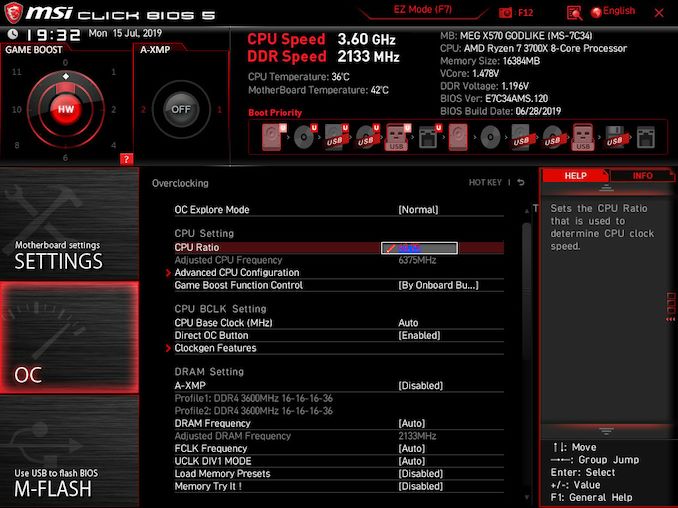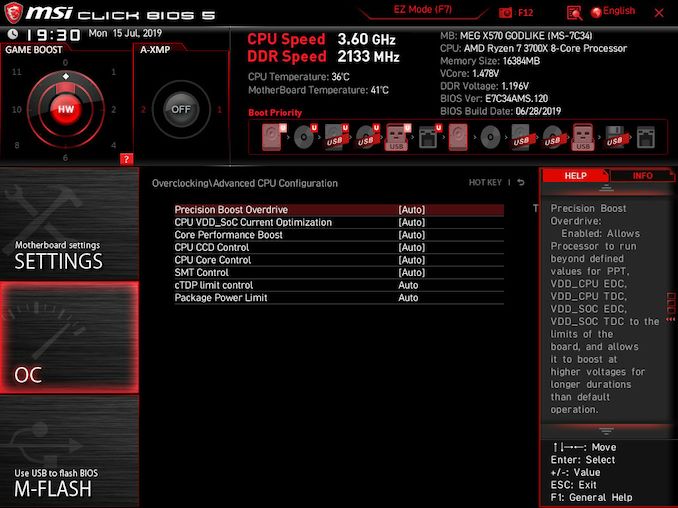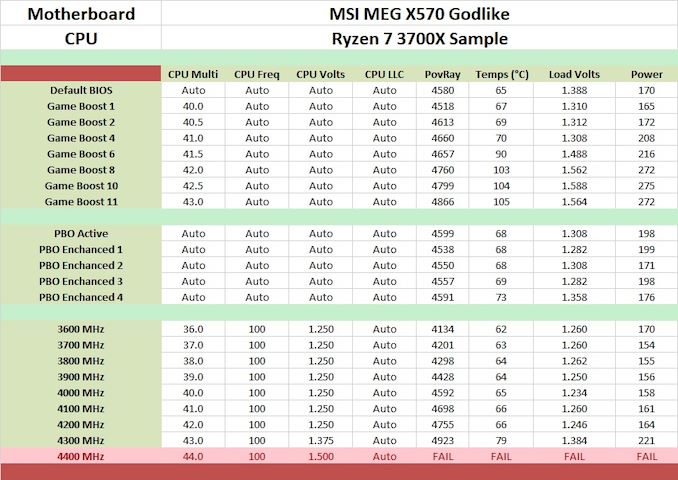The MSI MEG X570 Godlike Motherboard Review: Thor's Flagship
by Gavin Bonshor on August 28, 2019 12:00 PM EST- Posted in
- Motherboards
- AMD
- MSI
- 10G Ethernet
- Ryzen
- PCIe 4.0
- Ryzen 3000
- X570
- X570 Godlike
- MEG
Overclocking Ryzen 3000
Experience with the MSI MEG X570 Godlike
Overclocking with the Ryzen 3000 series hasn't exactly titillated users since its launch with there not being much headroom available. The biggest issue with this boils down to all-core overclocks being limited by the worst core of the chip. and the new 7 nm processors running quite warm. To get the best experience and results with the Ryzen 3000, users with good quality AIOs and custom water cooling yields the best outcome, and even with voltages of 1.375 V, these chips can run a little too warm for comfort.
The MSI Click BIOS 5 firmware is familiar to us and throughout the different chipsets including X399, X470, and Z390, the MSI MEG X570 Godlike uses the same design layout and setup. Within the OC section of the firmware, users can alter important settings such as the CPU ratio which can be changed in steps of 0.25 MHz, with relevant settings including CPU VCore, CPU Base Clock, and even FCLK frequency. Deeper into the firmware is settings to set the load line calibration (LLC) to a more aggressive or liberal profile, as well as all the Precision Boost Overdrive (PBO) settings.
The three main settings that PBO works from include package power tracking (PPT), thermal design current (TDC), and the electrical design current (EDC). All three of these can be set within the firmware under the advanced section of the Precision Boost Overdrive menu, although MSI has included four different PBO profiles for users to select from. The higher the setting, the higher the thermal and power draw will be, and it may not necessarily matter if a sub-par cooler is installed; it's noted that Ryzen 3000 processors work better when they are cooler.
There are seven different MSI Game Boost profiles to select from and users can access them via the dial at the bottom of the board, or through the firmware itself. The Game Boost profiles within the firmware can be accessed through the dial in the top left-hand corner. These profiles range from 4.0 GHz through to 4.3 GHz, and we've tested each of them below.
Overclocking Methodology
Our standard overclocking methodology is as follows. We select the automatic overclock options and test for stability with POV-Ray and OCCT to simulate high-end workloads. These stability tests aim to catch any immediate causes for memory or CPU errors.
For manual overclocks, based on the information gathered from the previous testing, starts off at a nominal voltage and CPU multiplier, and the multiplier is increased until the stability tests are failed. The CPU voltage is increased gradually until the stability tests are passed, and the process repeated until the motherboard reduces the multiplier automatically (due to safety protocol) or the CPU temperature reaches a stupidly high level (105ºC+). Our testbed is not in a case, which should push overclocks higher with fresher (cooler) air.
Overclocking Results
As it currently stands, MSI's Game Boost overclocking profiles need quite a bit of refinement, something they have informed us that these will be rectified with a new firmware revision; we will test this when we receive the board back from MSI. The issue with these is CPU VCore, or in a nutshell, too much of it which cross the board into the unsafe territory of the Ryzen 3000 processors safety limits; both in CPU VCore and in temperature. When we activated PBO and MSI's preset profiles for this, it didn't make much of an impact over the stock settings, which seems to be a reoccurring issue so far across the range of models we have tested so far.
Manually overclocking the MSI MEG X570 Godlike proved very fruitful and we managed to hit what seems to be the limits of our Ryzen 7 3700X testbed CPU with an overclock of 4.3 GHz all-cores with a CPU VCore of 1.35 V, which seems to be the brick wall for our processor. Even with a CPU VCore of 1.50 V, we couldn't get 4.4 GHz to remain stable when any kind of semi-intensive load was placed on the processor, although we did manage to boot into Windows 10 without fanfare with these settings. The performance wasn't throttled in POV-Ray throughout each of the frequencies tested and once the temperature limit of 110ºC is exceeded, the system will safely shut down. From 3.6 to 4.2 GHz, we managed to do this with a set CPU VCore of 1.250 V which did fluctuate slightly under load under the auto LLC setting. It is safe to say that the MSI MEG X570 Godlike doesn't have a VDroop issue and even at 4.3 GHz, a set CPU VCore of 1.375 resulted in a maximum load voltage of 1.384 V which isn't too far off the mark.













116 Comments
View All Comments
inighthawki - Wednesday, August 28, 2019 - link
The CPU is still quite often the bottleneck for games when running at high framerates.goatfajitas - Wednesday, August 28, 2019 - link
Possibly if you bought an $800 VC and have a mediocre $200 CPU, but that isnt realistically what anyone would have bought.inighthawki - Wednesday, August 28, 2019 - link
That's just not true. Go play a game at 720p on lowest settings and you'll very quickly see that even high end CPUs produce a noticeable bottleneck for achieving high framerates.The numbers are available to you as well. You can very easily go to Anandtech's bench numbers and compare any two high end CPUs and still see a difference in framerate across many games using the same GPU, even on medium to high settings. It's typically also quite apparent in the 95th percentile metrics.
Sure if the game is poorly optimized and doesn't offer enough control over graphics settings to reduce the GPU load enough, you won't see much of a difference because of course the GPU will remain the bottleneck in those cases. However if you're shooting for high framerates like 240hz, the CPU is almost always the bottleneck.
Qasar - Thursday, August 29, 2019 - link
inighthawki um, who would pay $800 for a vid card, and play games at 720P on the lowest settings, regardless what cpu you are running ? that could be done with a $400 vid card depending on the gameinighthawki - Thursday, August 29, 2019 - link
Because not all games are well optimized and can require a strong GPU to hit very high framerates even on low settings. Even with top of the line hardware (both CPU+GPU) on lowest settings, many games cant even hit a stable 144hz.Qasar - Friday, August 30, 2019 - link
i never understood the reason for needing high frame rates with games.. i have played a few of the games i have over the years with new hardware, and been able to get better FPS, and maybe its just me, but i dont notice the difference. inighthawki " many games cant even hit a stable 144hz. " and what does a refresh rate have to do with frames per second ?? my lowly 75hz monitor works just fine when the games i play are above 75 fps or hz29a - Friday, August 30, 2019 - link
Low (<60 fps) framerates give me nausea.Qasar - Friday, August 30, 2019 - link
29a, then i guess you cant play many console games :-) the games i play, even with the eye candy on max, less AA and AF, rarely go below 75 fps on the current hardware i have :-)inighthawki - Friday, August 30, 2019 - link
>> and what does a refresh rate have to do with frames per second ??Just my poor phrasing because I'm typing quickly. I mean that they cannot maintain 144fps on my 144hz display.
Perhaps you dont play any games where it makes a significant difference, but for a lot of games once you play at 144hz, playing on a 60hz display is like watching a slideshow. Playing over 75fps on your 75hz display may improve input latency for your game but it wont be any smoother.
Qasar - Friday, August 30, 2019 - link
inighthawki on the contrary, it is noticeably smoother, enough where i notice, and turn a few of the eye candy options down a little if it does look choppy. but i have tried playing a few games on monitors like that, and while it is nice.. not something i am after right now.. but as you mentioned.. could be cause of the games i play, dont need it.. i assume, then, you play a lot of 1st person shooters ?